OtterTune配置记录
0. 准备两台Ubuntu 18.04的虚拟机,安装mysql(供server-side存储调优数据用)和postgresql(供client-side存储业务数据用,这里以PostgreSQL为例。因为ottertune官方只给了postgres的knob configuration.....)。然后按照官方配置(https://github.com/cmu-db/ottertune/wiki/Linux-Quick-Setup)安装好必要的包。
Ref: https://www.cnblogs.com/leolztang/p/5094930.html
https://blog.csdn.net/skh2015java/article/details/80156278
https://blog.csdn.net/qq_19330913/article/details/80468494
https://www.cnblogs.com/hfdp/p/6088288.html
https://blog.csdn.net/chengyuqiang/article/details/70153980?utm_source=blogxgwz5
安装配置postgresql:
wget --quiet -O - https://www.postgresql.org/media/keys/ACCC4CF8.asc | sudo apt-key add -
sudo add-apt-repository "deb http://apt.postgresql.org/pub/repos/apt/ bionic-pgdg main"
sudo apt-get update
sudo apt-get install postgresql-9.6
sudo apt-get remove postgresql- #安装9.6时自动带上了10...不知道为啥。要卸载掉防止端口冲突。可以用sudo lsof -i:5432看一下 、修改postgres数据库用户的密码
打开客户端工具(psql)
sudo -u postgres psql
其中,sudo -u postgres 是使用postgres 用户登录的意思。PostgreSQL数据默认会创建一个postgres的数据库用户作为数据库的管理员,密码是随机的
postgres=# ALTER USER postgres WITH PASSWORD '******';
postgres=#为PostgreSQL下的命令提示符,--注意最后的分号; 、退出PostgreSQL psql客户端
postgres=# \q 、修改ubuntu操作系统的postgres用户的密码(密码要与数据库用户postgres的密码相同)
su root
删除PostgreSQL用户密码
sudo passwd -d postgres
passwd -d 是清空指定用户密码的意思
设置PostgreSQL系统用户的密码
sudo -u postgres passwd
按照提示,输入两次新密码 、修改PostgresSQL数据库配置实现远程访问
sudo gedit /etc/postgresql/9.6/main/postgresql.conf
.监听任何地址访问,修改连接权限
#listen_addresses = 'localhost' 改为 listen_addresses = '*'
.启用密码验证
#password_encryption = on 改为 password_encryption = on
. 确保端口为5432
port = # (change requires restart) sudo gedit /etc/postgresql/9.6/main/pg_hba.conf
在文档末尾加上以下内容
host all all 0.0.0.0/ trust 、重启服务
/etc/init.d/postgresql restart 、5432端口的防火墙设置
5432为postgreSQL默认的端口
sudo iptables -A INPUT -p tcp -m state --state NEW -m tcp --dport -j ACCEPT 安装好之后可以
psql -U postgres -h 192.168.1.170
测试一下 Ref: https://blog.csdn.net/zj0078/article/details/71156064
修改系统默认python版本
原因:ubuntu系统安装了python2.7和python3.,默认使用的是python 2.7。导致从2.7找不到包
解决办法:使用以下命令来修改默认python版本: sudo cp /usr/bin/python /usr/bin/python_bak
sudo rm /usr/bin/python
sudo ln -s /usr/bin/python3. /usr/bin/python 这样在终端中运行Python时,默认启动的就是3.6版本了
如果在C2步骤中出错,那么还需要修改默认java版本
sudo update-alternatives --config java 选择/usr/lib/jvm/jdk1.8.0_212/bin/java 所在的number
OtterTune分为两部分:server side: 包括一个MySQL数据库(用于存储调优数据,供ml model用),Django(FrontEnd User Interface),Celery(用于调度ML task);client side: Target_DBMS(存储用户的业务数据用,支持多种DBMS),Controller(用于控制target DBMS),Driver(用于调用controller,入口是fabfile.py)
Ref: https://github.com/cmu-db/ottertune/wiki/Getting-Started-ottertune
https://blog.csdn.net/weixin_40449300/article/details/87904128
https://blog.csdn.net/u013385018/article/details/84028360
https://blog.csdn.net/u013385018/article/details/84201771
说实话见到很多帖子都在讨论它,但大多都是空泛的复述论文,实际上很少有人真正deploy过......这点还是挺让我惊讶的
-------------------------------------------Test OtterTune with real target DBMS-------------------------------------------
这里以postgreSQL为例。
按照S1, S2, C1, C2, C3, C4, C5, S3, S4, C6的顺序执行如下步骤即可

-----------------------------------------------------Server-side配置-----------------------------------------------------
S1. 新建名为ottertune的数据库
mysqladmin create -u root -p ottertune
S2. 编辑配置文件
cd /ottertune/server/website
cp website/settings/credentials_TEMPLATE.py website/settings/credentials.py
并填入USERNAME, PASSWORD等信息,设置DEBUG=True
示例文件:
#
# OtterTune - credentials_TEMPLATE.py
#
# Copyright (c) -, Carnegie Mellon University Database Group
#
"""
Private/custom Django settings for the OtterTune project. """
# pylint: disable=invalid-name # ==============================================
# SECRET KEY CONFIGURATION
# ============================================== # SECURITY WARNING: keep the secret key used in production secret!
SECRET_KEY = 'ADD ME!!' # ==============================================
# DATABASE CONFIGURATION
# ============================================== DATABASES = {
'default': {
'ENGINE': 'django.db.backends.mysql',
'NAME': 'ottertune',
'USER': 'root',
'PASSWORD': '',
'HOST': '',
'PORT': '',
'OPTIONS': {
'init_command': "SET sql_mode='STRICT_TRANS_TABLES',innodb_strict_mode=1",
},
}
} # ==============================================
# DEBUG CONFIGURATION
# ============================================== # Can override the DEBUG setting here
DEBUG = True # ==============================================
# MANAGER CONFIGURATION
# ============================================== # Admin and managers for this project. These people receive private
# site alerts.
ADMINS = (
# ('Your Name', 'your_email@example.com'),
)
MANAGERS = ADMINS # ==============================================
# GENERAL CONFIGURATION
# ============================================== # Hosts/domain names that are valid for this site; required if DEBUG is False
# See https://docs.djangoproject.com/en/1.5/ref/settings/#allowed-hosts
ALLOWED_HOSTS = []
S3:Set up Django(用于监控)
Firstly, you need to migrate the Django models into the database. (相当于配置Django网站后端,将需要的表放进mysql的OtterTune数据库内)
python3 manage.py makemigrations website
python3 manage.py migrate
Create the super user
python manage.py createsuperuser
这一步操作完成后,将在mysql的OtterTune数据库中建立如下表:
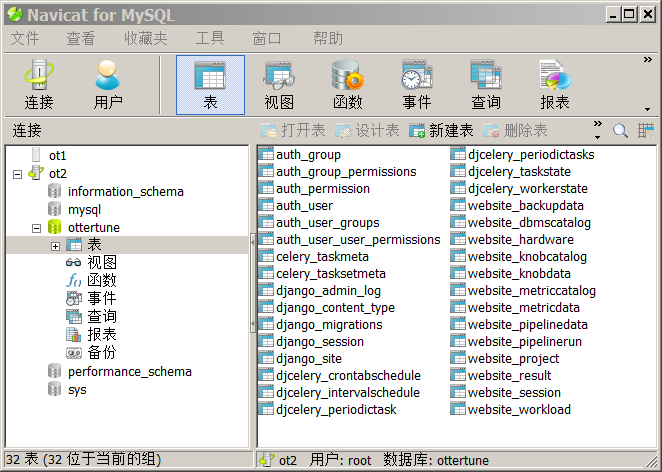
值得注意的是website_knobcatalog和website_metriccatalog这两个表,分别存储了待观测的knob和metric名称。这是dump出来的表内容(以postgresql为例)
S4:Start Celery(用于调度ML task)
OtterTune uses Celery to schedule machine learning tasks. Before staring the celery worker, you may want to start a message broker required by celery. In our case, we use RabbitMq.
sudo rabbitmq-server -detached
Then you can start the celery worker:
python3 manage.py celery worker --loglevel=info --pool=threads
Then you can start Django Server:
python manage.py runserver 0.0.0.0:8000
OtterTune has periodical ML tasks (i.e. knob identification and metrics pruning), which run every time period. You can use celery beat to start the periodical tasks.
python3 manage.py celerybeat --verbosity=2 --loglevel=info
完成后打开http://127.0.0.1:8080,在里面建立一个tuning session,并记下upload code
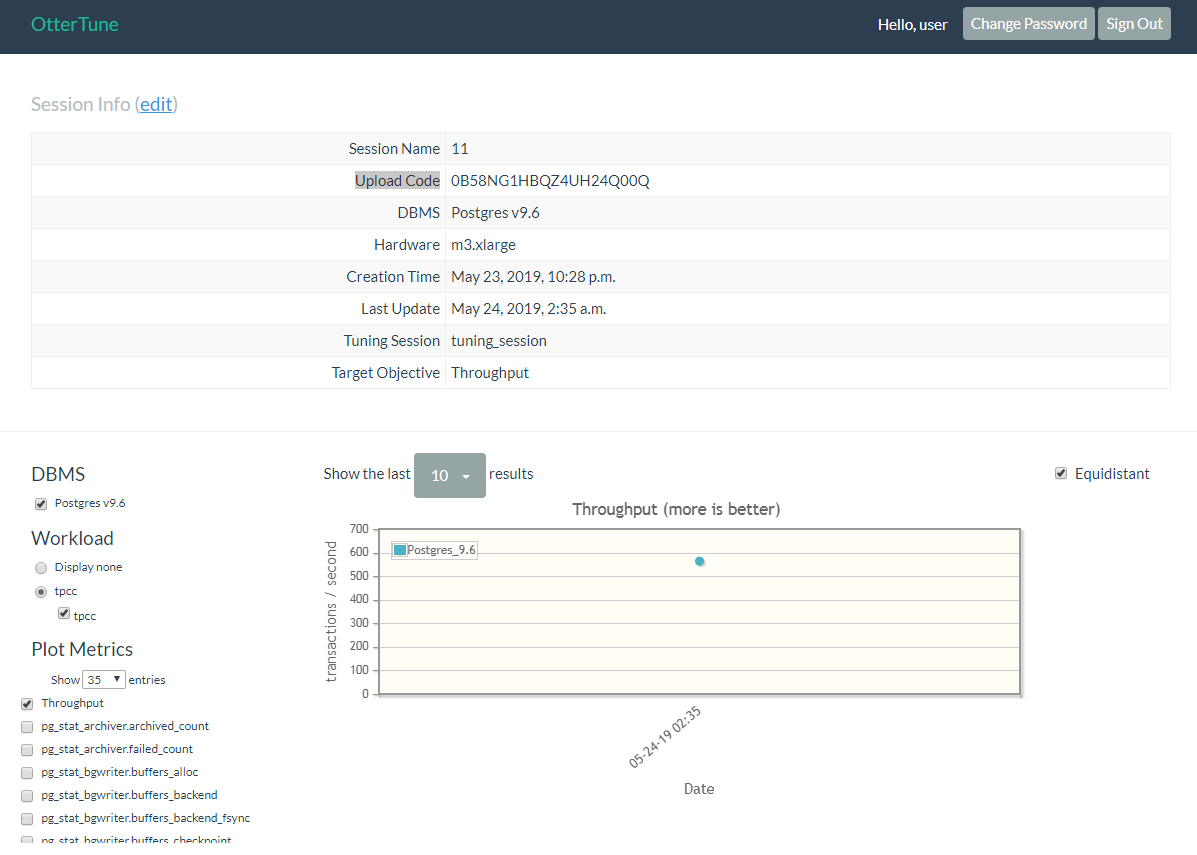
-----------------------------------------------------Client-side配置-----------------------------------------------------
首先将ottertune、oltpbench都git clone到home/username/下面
C1. 编辑/ottertune/client/driver/driver_config.json,填入target DBMS类型、用户名密码等信息,并填写其中涉及到的所有配置文件
注意
1. 对于save_path这一项,要事先建立好对应的文件夹
2. 对于upload code这一项,要和S4中分配给的upload code一致
示例文件:
-------------/ottertune/client/driver/driver_config.json-------------
{
"database_type" : "postgres",
"database_name" : "tpcc",
"database_disk": "/dev/sda1",
"database_conf": "/etc/postgresql/9.6/main/postgresql.conf",
"database_save_path": "/home/tidb/ottertune",
"username" : "postgres",
"password" : "******",
"oltpbench_home": "/home/tidb/oltpbench",
"oltpbench_config": "/home/tidb/oltpbench/config/tpcc_config_postgres.xml",
"oltpbench_workload": "tpcc",
"oltpbench_log" : "/home/tidb/ottertune/client/driver/oltp.log",
"controller_config": "/home/tidb/ottertune/client/controller/config/sample_postgres_config.json",
"controller_log" : "/home/tidb/ottertune/client/driver/controller.log",
"save_path": "/home/tidb/ottertune/server/results",
"upload_url" : "http://127.0.0.1:8000",
"upload_code" : "0B58NG1HBQZ4UH24Q00Q",
"lhs_knob_path" : "/home/tidb/ottertune/client/driver/knobs/postgres-96.json",
"lhs_save_path" : "/home/tidb/ottertune/client/driver/configs"
} -------------/home/tidb/ottertune/client/controller/config/sample_postgres_config.json-------------
{
"database_type" : "postgres",
"database_url" : "jdbc:postgresql://localhost:5432/postgres",
"username" : "postgres",
"password" : "asdfgh",
"upload_code" : "DEPRECATED",
"upload_url" : "DEPRECATED",
"workload_name" : "tpcc"
} -------------/oltpbench/config/tpcc_config_postgres.xml-------------
<?xml version="1.0"?>
<parameters> <!-- Connection details -->
<dbtype>postgres</dbtype>
<driver>org.postgresql.Driver</driver>
<DBUrl>jdbc:postgresql://localhost:5432/tpcc</DBUrl>
<username>postgres</username>
<password>******</password>
<isolation>TRANSACTION_READ_COMMITTED</isolation> <!-- Scale factor is the number of warehouses in TPCC -->
<scalefactor></scalefactor> <!-- The workload -->
<terminals></terminals>
<works>
<work>
<time></time>
<rate></rate>
<ratelimited bench="tpcc">true</ratelimited>
<weights>,,,,</weights>
</work>
</works> <!-- TPCC specific -->
<transactiontypes>
<transactiontype>
<name>NewOrder</name>
</transactiontype>
<transactiontype>
<name>Payment</name>
</transactiontype>
<transactiontype>
<name>OrderStatus</name>
</transactiontype>
<transactiontype>
<name>Delivery</name>
</transactiontype>
<transactiontype>
<name>StockLevel</name>
</transactiontype>
</transactiontypes>
</parameters>
C2. 配置oltpbench(用于周期性在target DBMS上run benchmark):参考https://github.com/oltpbenchmark/oltpbench/wiki#Environment%20Setup
如果出现错误,sudo update-alternatives --config java,选择/usr/lib/jvm/jdk1.8.0_212/bin/java 所在的number
C3. 在target DBMS(postgres)中新建名为tpcc的数据库,供oltpbench用
psql -U postgres -h 192.168.1.170
postgres=# create database tpcc owner postgres;
postgres=# grant all privileges on database tpcc to postgres;
C4. load oltpbench into target DBMS
./oltpbenchmark -b tpcc -c config/tpcc_config_postgres.xml --create=true --load=true
C5. Build controller
cd ottertune/client/controller
gradle build
C6. 运行
运行时发现几个bug:
1. 在ottertune/client/driver/fabfile.py line236, 'Output into file' 需要改为 'Output Raw data into file'
2. loop一次之后发现这玩意把我的postgreSQL的配置(postgresql.conf)改崩溃了......感觉要自己魔改一番了...
目测是ottertune在修改时没有考虑好数据类型(原版的random_page_cost值是4.0 科学计数法在这里肯定是认不出来的啊)
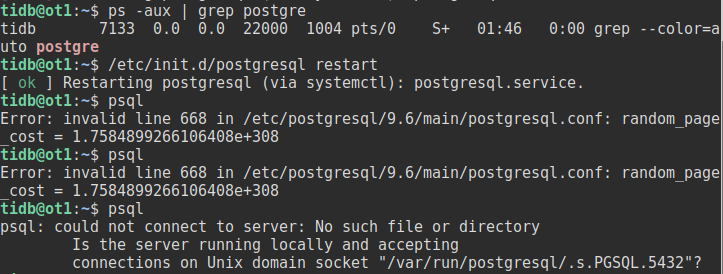
After setting the above three configurations, you can run the loop in the description above. In each loop, it collects target DBMS info, uploads to the server, gets new recommended configuration, installs the config and restarts DBMS. Users can continue to run loops until they are satisfied with the recommended configuration. Functions are defined in the driver file ottertune/client/driver/fabfile.py
fab loop runs one single loop.
fab run_loops:max_iter=10 runs 10 loops. You can set max_iter to change the maximum iterations.
注意在刚开始运行时,因为ML model缺乏足够的训练数据,所以生成的configuration可能是random的:
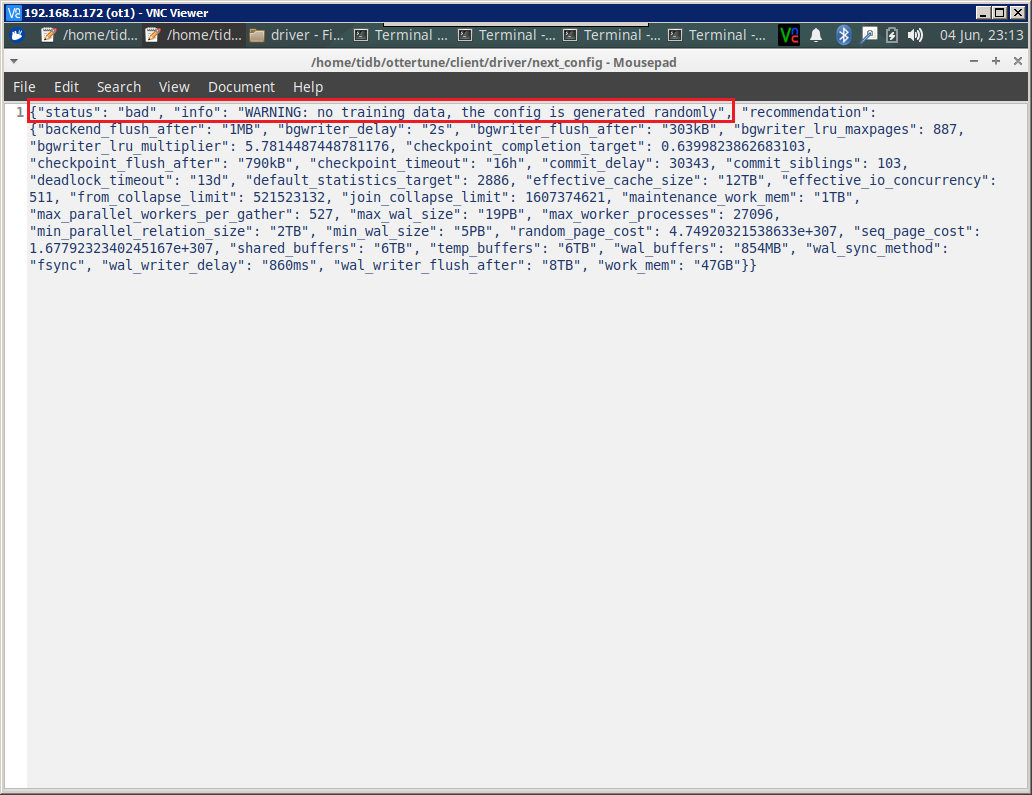
-------------------------------------------Test OtterTune with fake workload data-------------------------------------------
这里fake workload data是用data_generator.py自己random生成出来的,不是真的在target DBMS上跑出来的knob-metric samples。
个人感觉这个就是用来测试下django interface的显示效果....实际意义不大
F0:首先完成上面的S1, S2, C1, C2, C3, C4操作
F1:生成一些fake workload data
cd /ottertune/server/website/script/controller_simulator/
python data_generator.py 2 5
这里2表示workload数量(模拟在target DBMS跑过的不同workload)
5表示对于每个workload,会被观测到的训练样本数(knob/metric samples. 模拟每个workload在target DBMS上观测到的结果)
生成好的数据会被放在generated_data文件夹下
F2:Initialize Django Server,初始化ottertune MySQL数据库
cd /ottertune/server/website fab
fab create_test_website
F3:启动Django
fab start_debug_server
F4:上传fake workload data到Django interface
cd /ottertune/server/website/script/controller_simulator/
python upload_data.py ./generated_data 0987654321
[其中0987654321是upload code,和下图网页上的upload code对应。详细可参考 https://github.com/cmu-db/ottertune/wiki/Finding-a-Session's-Upload-Code ]
在bash中可以看到,当上传好后,系统就会自动运行ML pipeline
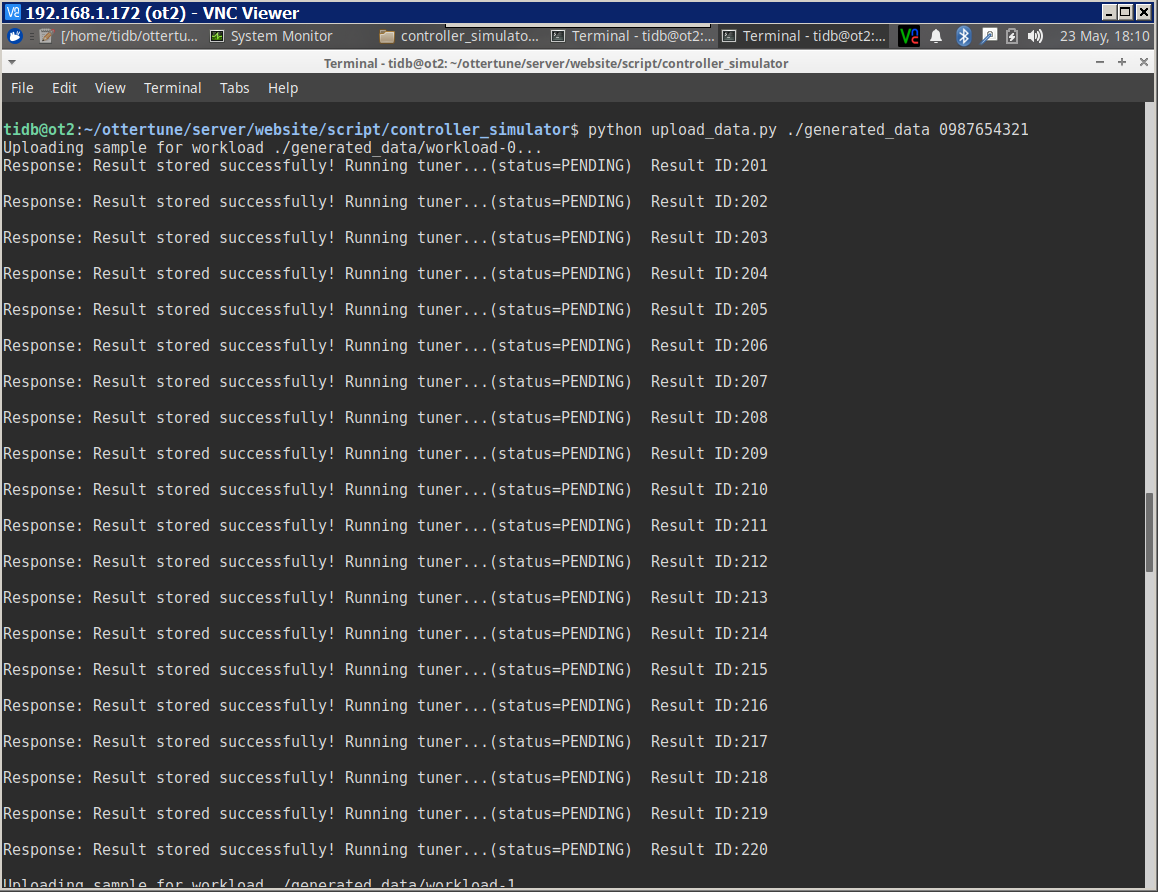
F5:进入http://192.168.1.172:8000,用user/abcd123登陆,单击test_project -> tuning_session.
左边可以选择workload和要优化的metric,右边就可以看到metric在不同knob configuration下的表现。点击下面具体的Result ID就可以看到这一metric value对应的knob
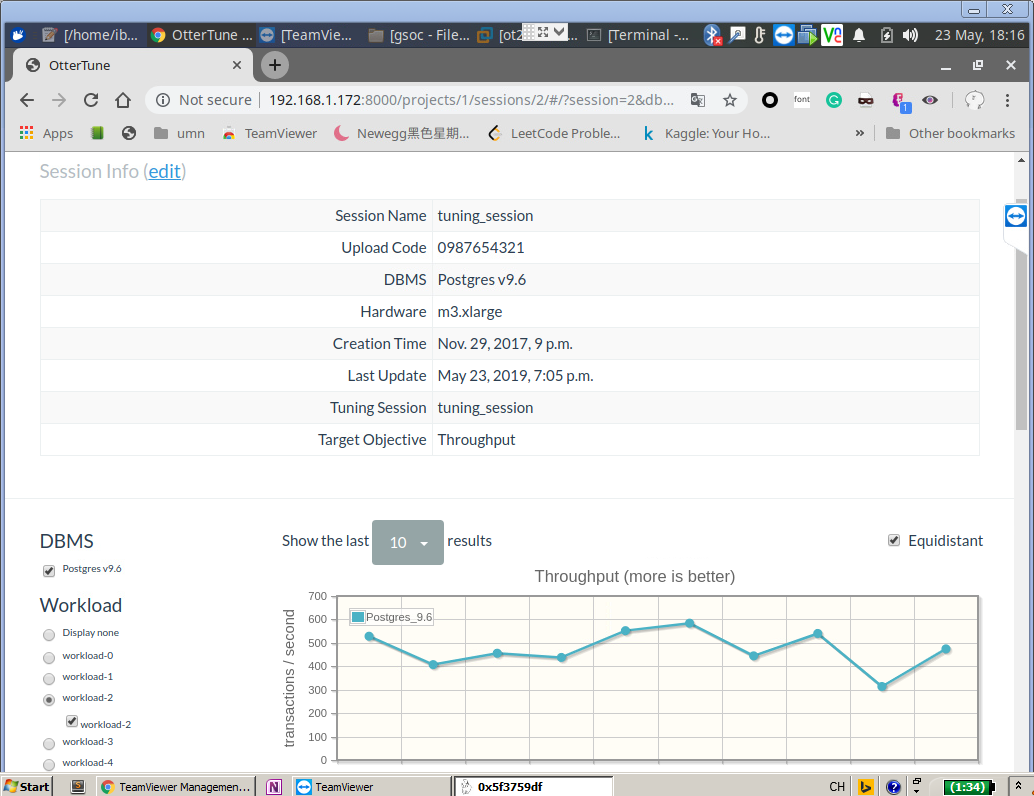
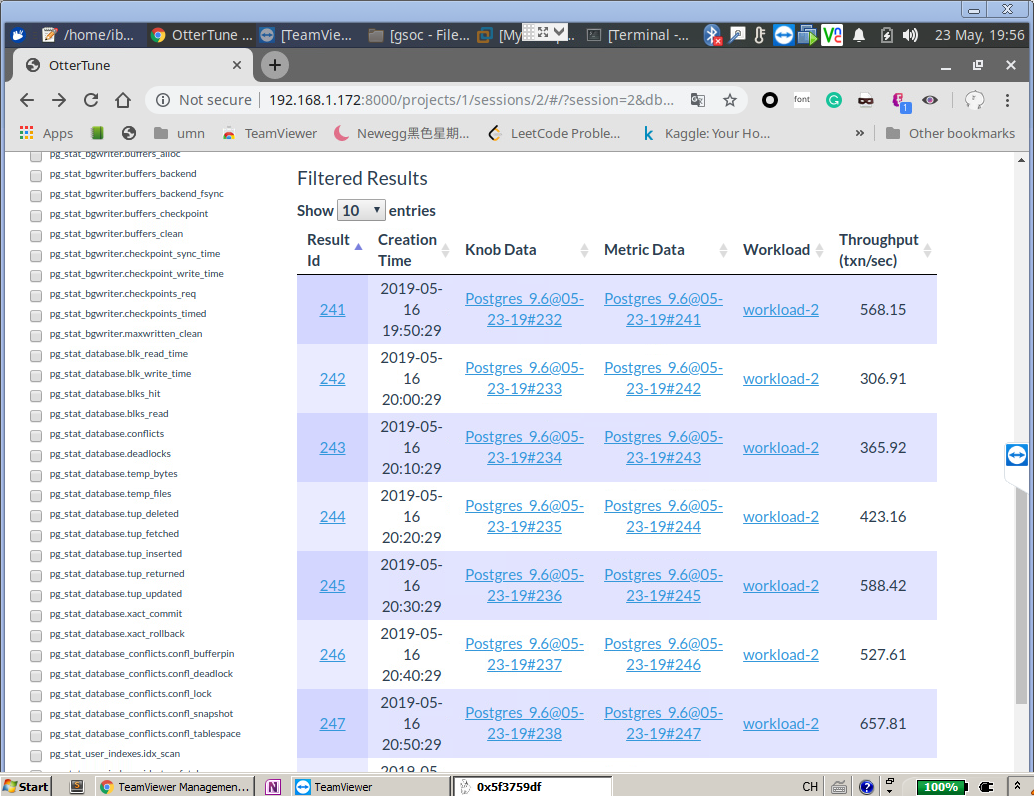
OtterTune配置记录的更多相关文章
- Bandwagon的配置记录(二) —— ftp文件传输
SSH登录服务器 登录的方法在Bandwagon的配置记录(一) —— kexue上网 配置前的准备 1.新建一个目录( /home/ftp ),以后可以把文件放在这里,这里相当于是个中转站 cd ...
- kafka配置记录
1. 准备三台机器,系统CentOs6 2. 安装好JDK和zookeeper 参考: zookeeper配置记录 3. 解压安装包到指定目录 tar -zxvf kafka_2.12-2.1.0.t ...
- spring cloud config配置记录
1. spring cloud config配置记录 1.1. pom <!-- 分布式配置中心 --> <dependency> <groupId>org.spr ...
- 使用SecureCRT / win7远程桌面连接ubuntu配置记录(有更新)
2017-03-03 更新于末尾 1.Windows7 — Ubuntu 远程桌面连接中 Tab 键不能补全的解决办法 2.xrdp远程连接ubuntu无法使用原机的中文输入法 2017-02-22 ...
- MAC OS X Yosemite的PyQt4配置记录
MAC OS X Yosemite的PyQt4配置记录 声明: 1)本报告由博客园bitpeach撰写,版权所有,免费转载,请注明出处,并请勿作商业用途. 2)若本文档内有侵权文字或图片等内容,请联系 ...
- (转)Nginx的https配置记录以及http强制跳转到https的方法梳理
Nginx的https配置记录以及http强制跳转到https的方法梳理 原文:http://www.cnblogs.com/kevingrace/p/6187072.html 一.Nginx安装(略 ...
- jenkins配置记录
jenkins配置记录 http://www.cnblogs.com/kevingrace/p/6022447.html
- Vue-cli 多页相关配置记录
Vue-cli 多页相关配置记录 搭建一个顺手的MPA项目脚手架,其实根据项目的不同目录结构和打包配置都可以进行灵活的调整.这次的项目可能是包含各种客户端和管理后台在一起的综合项目所以需要将样式和脚本 ...
- 使用SecureCRT连接虚拟机(ubuntu)配置记录
这种配置方法,可以非常方便的操作虚拟机里的Linux系统,且让VMware在后台运行,因为有时候我直接在虚拟机里操作会稍微卡顿,或者切换速度不理想,使用该方法亲测本机效果确实ok,特此记录. Secu ...
随机推荐
- reverse/inverse a mapping but with multiple values for each key
reverse/inverse a mapping but with multiple values for each key multi mappping dictionary , reverse/ ...
- Quick BI支持哪些数据源(配置操作篇)
Quick BI 潜心打造了核心技术底座(OLAP分析引擎),实现了SQL解析.SQL调度.SQL优化.查询加速等基础能力,支撑Quick BI的数据分析和查询加速.OLAP分析引擎包括数据源连接.数 ...
- React Native 之FlatList 下拉刷新和上拉加载更多
接上一篇代码: 只修改了FlatListDemo.js里面的代码 import React, {Fragment,Component} from 'react'; import { SafeAreaV ...
- wxy和zdy眼中的水题 地精部落 dp
题目描述 传说很久以前,大地上居住着一种神秘的生物:地精. 地精喜欢住在连绵不绝的山脉中.具体地说,一座长度为 N 的山脉 H可分 为从左到右的 N 段,每段有一个独一无二的高度 Hi,其中Hi是1到 ...
- 【gym102222K】Vertex Covers(高维前缀和,meet in the middle)
题意:给定一张n点m边的图,点带点权,定义点覆盖的权值为点权之积,问所有点覆盖的权值之和膜q n<=36, 1<=a[i]<=1e9,1e8<=q<=1e9 思路:n&l ...
- #1126-JSP HTTP状态码
JSP HTTP状态码 HTTP请求与HTTP响应的格式相近,都有着如下结构: 以状态行+CRLF(回车换行)开始零行或多行头模块+CRLF一个空行,比如CRLF可选的消息体比如文件,查询数据,查询输 ...
- $FFT/NTT/FWT$题单&简要题解
打算写一个多项式总结. 虽然自己菜得太真实了. 好像四级标题太小了,下次写博客的时候再考虑一下. 模板 \(FFT\)模板 #include <iostream> #include < ...
- uniapp开发
问题1:去掉导航条 给一个单独的页面隐藏顶部的 导航栏 可以在pages.json里 单独的路由style下面配置 "app-plus": {"titleNView&q ...
- 高通 8x26 andorid light sensor(TSL258x) 开发【转】
本文转载自:http://www.voidcn.com/blog/u012296694/article/p-1669831.html 前言 8926平台的sensor架构与之前的平台完全不同,实际上已 ...
- str_shuffle函数
str_shuffle() 函数打乱一个字符串,使用任何一种可能的排序方案. <?php $str = 'hello world '; echo str_shuffle($str); ...
